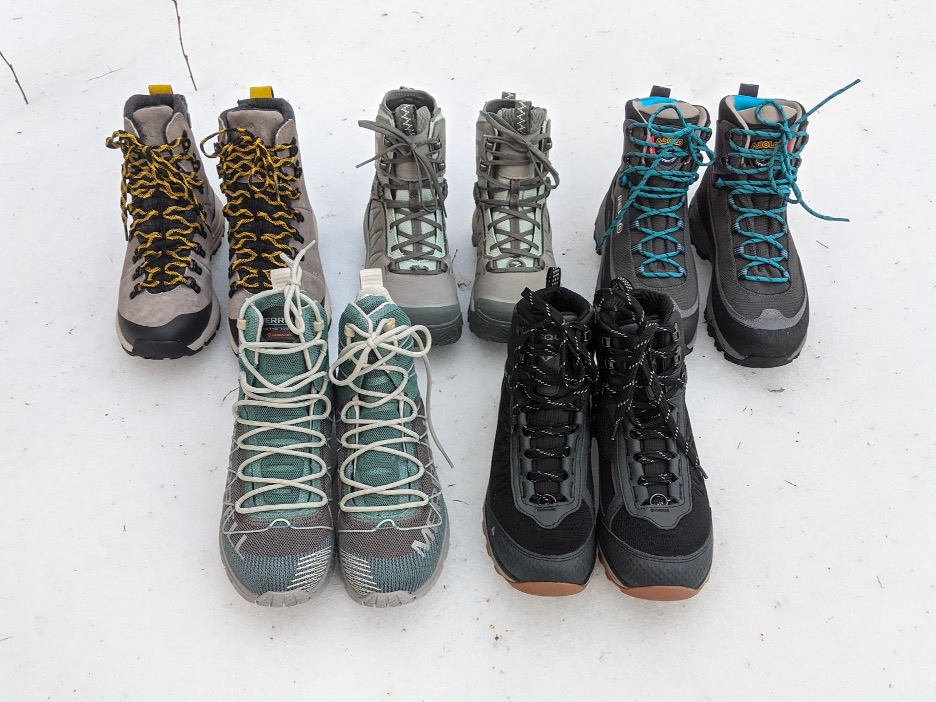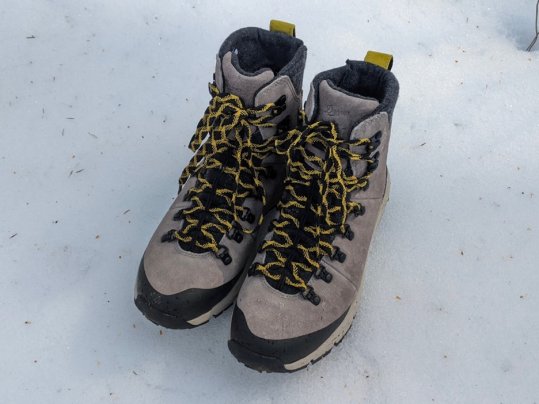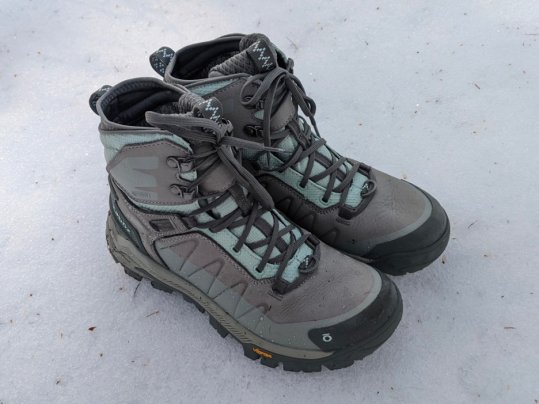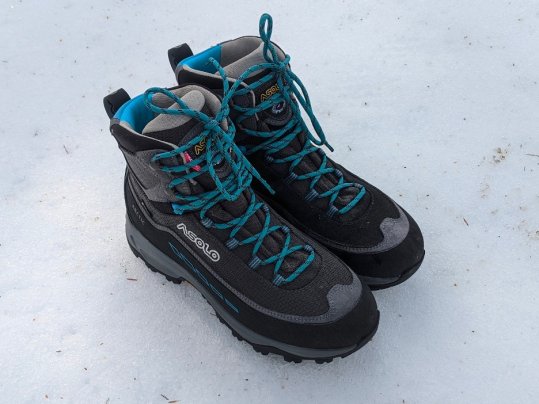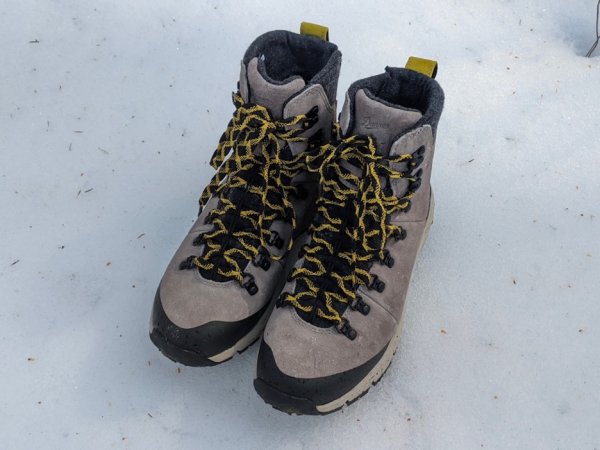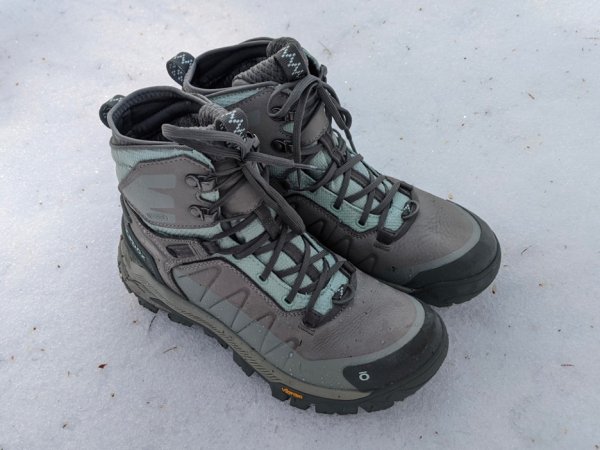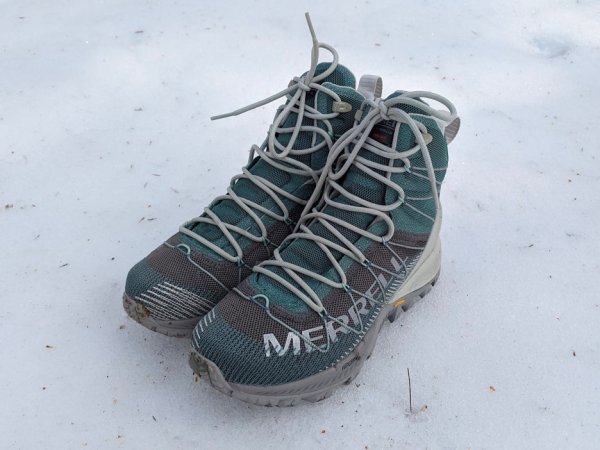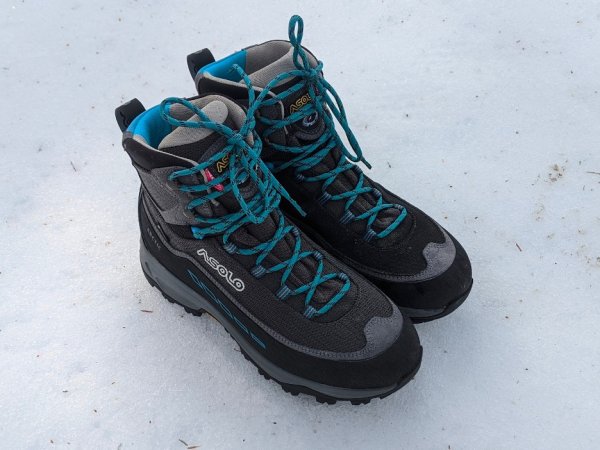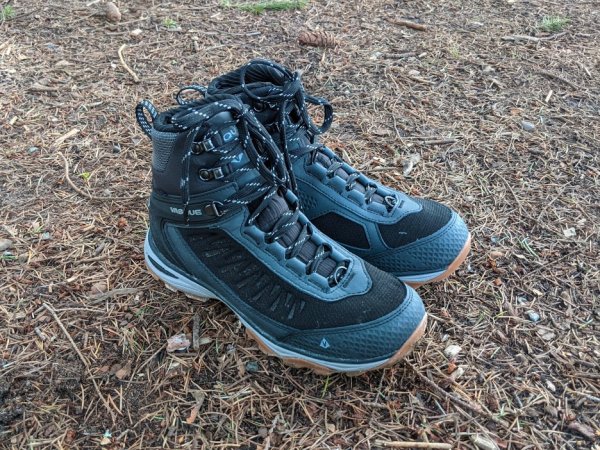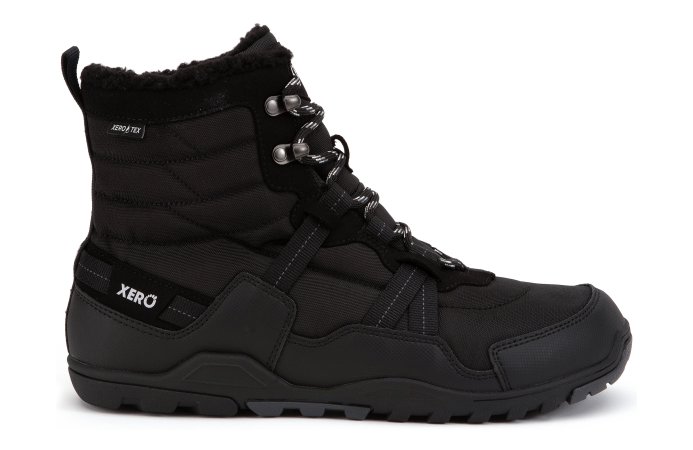We may earn revenue from the products available on this page and participate in affiliate programs. Learn More ›
Anyone who has ever tried to hike in snow knows the importance of a great winter hiking boot. First, there’s the slip factor on surfaces that range from deep powder to black ice. Then there’s all that moisture surrounding your foot—if there is a weakness in the waterproofing of your boot, winter will find it. Finally, it’s just so cold. To help you level up to a pair of the best winter hiking boots, I took five top models into the field for a series of side-by-side tests.
- Best Overall: Danner Arctic 600
- Best Value: Oboz Bangtail
- Best Lightweight: Merrell Thermo Rogue
- Best for Bluebird Days: Asolo Arctic
- Best Budget: Vasque Coldspark
- Best Minimalist: Xero Shoes Alpine
Testing the Best Winter Hiking Boots

All of the boots in this story were tested under the same criteria as those in my best waterproof hiking boot story, but the winter boots for hiking were subjected to an additional set of tests. For the first test, I stood in each shoe in the Middle Fork of the Snoqualmie River in March to test their insulation, noting how long it took for my feet to start to get cold. In between tests I warmed up my feet again by briskly hiking before moving on to the next set of shoes.
Next I checked their traction on icy surfaces. Finally, I checked the level of protection provided by the boot when I postholed through the upper crust of mid-morning snow. I also tested several winter hiking boots more than once (typically wearing a different boot on each foot) to get a better feel for their comparative performance.
Read Next: The Best Hiking Boot Brands
When choosing a winter hiking boots, keep in mind that the fit of each boot, as well as your personal preference for arch support, can vary widely. What boot fits best for one person may not be what fits best for another. Before making a final purchase decision, try each boot on at home and assess whether the comfort and level of support provided is adequate to your needs.
For this story, I tested the best winter hiking boots for women. Links to the associated best winter hiking boots for men have been provided below.
The Best Winter Hiking Boots: Reviews and Recommendations
Best Overall: Danner Arctic 600
Key Features
- Sizes: Men’s 7-14 (wide available); women’s 5-11
- Outsole: Vibram Nisqually Arctic Grip
- Insulation: 200g Primaloft Gold
- Danner Dry liner
Pros
- Best traction on ice in my test
- Very warm
- Side zip allows for easy on and off
Cons
- Side zip represents a point of failure
The Danner Arctic 600 performed exceptionally well on every test I threw at it. The Vibram Arctic Grip outsole (in combination with this shoe’s lug design) was extremely impressive. The stickiness of the traction meant I could barely tell I was walking on ice—it was almost impossible to slip with these shoes. Similarly this shoe stayed warmer than every other boot in my test while standing in the early spring runoff of the Middle Fork of the Snoqualmie River, and no moisture made its way into the boot. I did note, however, that this otherwise weatherproof boot was the coldest at the side zipper.

The Danner Arctic 600’s side zipper was an unusual feature among the boots that I tried. While putting on and taking off boots seemingly every fifteen minutes, I appreciated that I could put on and remove these shoes without having to untie and retie the laces.

While zippers may make things easier with a casual winter boot, zippers represent a significant failure point on just about any piece of gear—and that goes double for waterproof zippers like those on the Arctic 600. If you are concerned about the long-term durability of the zipper (and I would be), consider not using this feature on a day-to-day basis.
Best Value: Oboz Bangtail
Key Features
- Sizes: Men’s 8-14; Women’s 5-12
- Outsole: Vibram Arctic Grip
- Insulation: 200g Primaloft BIO
- B-Dry waterproof membrane
Pros
- Great traction
- Very warm
- Waterproof
Cons
- Just barely outperformed by the Danner Arctic 600
During testing, the Danner Arctic 600 and the Oboz Bangtail were neck and neck. Both used a variation of the best-in-class Vibram Arctic Grip outsole, and thus both had excellent traction on ice—but the Arctic 600 just squeaked ahead. Then, when I was testing the warmth of these insulated hiking boots, I had to run a separate test just to compare these two shoes side by side, with, again the Arctic 600 just ahead. It was almost too close to call.


But there are lots of reasons to choose the Oboz Bangtail over the Danner Arctic 600. First off, it’s less expensive for the same quality, which makes a difference with pricey boots. Next, it has better protection. The extra padding at the upper and a more robust bumper at the toe, while still weighing about the same as the Danner Arctic 600. Finally, it doesn’t have a side zip, which, while convenient, represents a point of failure that most serious adventurers would be happier without.
Best Lightweight: Merrell Thermo Rogue
Key Features
- Sizes: Men’s 7-15; women’s 5-9
- Outsole: Vibram Arctic Grip All Terrain
- Insulation: 200 grams Primaloft Gold Eco Series
- GORE-TEX waterproof membrane
Pros
- Lightweight
- Good traction
Cons
- Gets cold fairly quickly when subjected to cold water
- Flexible upper provides less protection when postholing than other winter hiking boots
Everything about hiking in winter is heavier. Your pack is heavier, your clothes are heavier. And your shoes: they are a lot heavier—likely twice the weight of your warm-weather kicks. And while it’s easy to forget that your shoes are heavier when you first start hiking, the reality is that the biomechanics of your body are such that extra weight on your feet is worth as much as five times that on your back. So there’s a good reason to search out a quality lightweight winter hiking boot.
Not only was the Merrell Thermo Rogue the lightest winter hiking boot I looked at—just over two pounds for a pair, it also performed impressively during most of my testing protocol. Like the Danner Arctic 600 and the Oboz Bangtail, it sports a variation of the Vibram Arctic Grip and was pretty grippy when walking on ice. I had to step more carefully than with the other two boots, but I would be confident walking on most level icy surfaces with the Merrell Thermo Rogue. It also handled the waterproofing test admirably well, staying dry for 14 hours when left in standing water.
When I first laced up the Merrell Thermo Rogues I noticed they warmed up fast compared to the Oboz Bangtail on the brief, fast-paced hike I took them out on before the insulation test. But when I stepped into the icy cold water of the Snoqualmie River, the situation changed rapidly. In fact, my feet got so cold so quickly that I thought water was seeping in through the top of the shoe (which was not included as part of standing water test) and I ended the test earlier than planned. However, when I went to check my sock after wrapping up with the Oboz Bangtail, I found that my foot was completely dry: the Merrell Thermo Rogues had just lost its insulative powers after only a couple of minutes of standing in cold water. To confirm this, I retested the shoes, this time being sure to lace them up tightly to prevent as much water from seeping in around the laces as possible. This made a slight difference in how quickly my foot got cold, but it was still nowhere near the performance of either the Oboz Bangtail or the Danner Arctic 600.
Best for Bluebird Days: Asolo Arctic
Key Features
- Sizes: Men’s 8-12; Women’s 6-9
- Outsole: Vibram Ghiaccio with Arctic Grip Compound
- Insulation: Gore-Tex Insulated Comfort Footwear
- Also features water-resistant suede
Pros
- Includes RECCO Rescue System Technology
- Resoleable
- Warmest boot in my test when dry
Cons
- Not fully waterproof
- Less grippy on ice than other boots in my test
- Expensive
The Asolo Arctic was easily one of the best winter hiking boots I looked at, except for one pretty serious Achilles heel: it’s not fully waterproof. It is, however, extremely water resistant. It was only slightly damp on the inside after 14 hours in standing water, and during the insulation test it took about six minutes for the cold water of the Snoqualmie River to make its way into the boot. Until that point, the Arctic Asolo was arguably the warmest boot I had tested, but after that? Game over. So if you live in a dry climate—looking at you Coloradans—then this is an excellent choice for all those bluebird days.

Those adventurers will also appreciate some of the added features of the Asolo Arctic. First off: these boots can be resoled, which significantly cuts down on your costs over time (and saves you on having to break in a new pair of winter hiking boots every few seasons). I also liked that it included RECCO Rescue System Technology, allowing professional rescuers equipped with RECCO detectors to more easily find you in the case of an SAR event.
Read Next: Best Avalanche Shovels

While the outsole of the Asolo Arctic does contain some of the Vibram Arctic Grip compound, my experience during testing was that care will need to be taken on especially slick and icy surfaces to avoid falling.
Best Budget: Vasque Coldspark
Key Features
- Sizes: Men’s 8-12; women’s 6-9
- Outsole: Vasque Monolith with ColdHold compound
- Insulation: Retain
- UltraDry waterproofing
Pros
- Affordable
Cons
- Not waterproof
- Poor traction on icy surfaces
For plenty of people, it can be hard to justify the cost outlay of a true winter hiking boot. They are expensive—often as much as $100 more expensive than their summer counterparts—and, for most people, simply don’t get as much use. The Vasque Coldspark stood out in my test for its comparative affordability, but it’s worth looking at how it performed during testing before deciding it’s the right boot for you.
The biggest issue with this boot is that it simply isn’t waterproof enough for hiking in either rainy or slushy conditions, and it certainly isn’t waterproof enough to cross shallow streams in. During my insulation test, not only did my feet start to get cold as soon as I stepped into the cold water, they were also wet in less than two minutes.
I was also disappointed by the traction of the Vasque Coldspark on icy surfaces. While other winter hiking boots in this test provided enough grip that you could get away with leaving your YakTrax at home (at least as long as you were careful), these shoes slipped and slid across the icy surface, providing only marginally more grip than my standard hiking boots.
That all being said, these are still better for winter than most of the best hiking boots, so if you’re looking to upgrade your winter kit and want to save funds for other parts of your setup, this is an option to consider.
Best Minimalist: Xero Shoes Alpine
Key Features
- Sizes: Men’s: 6.5-15; women’s: 5-10.5
- Stack Height: 7.5mm
- Weight: 28.6 ounces for a women’s 9
- Fits true to size
Pros
- Warm enough to take out into snow conditions
- Reasonably waterproof
- Comparatively affordable
Cons
- Less flexible sole than other minimalist shoes or boots
- Not appropriate for individuals unaccustomed to minimalist shoes
During my test of the best minimalist shoes for hiking and trail running there was one option that was far and away the best for winter hiking: the Xero Shoes Alpine.

I took the Xero Shoes Alpine out on an overnight snowshoe that saw temps dip well below freezing and was impressed with how well they performed. On the trek up, my feet were completely warm in a single pair of thick ski socks, including during breaks (they did finally get a little chilly when I was eating dinner). During testing, I found that these shoes were reasonably waterproof. My feet were dry over 14 miles of snowshoeing. They’d be fine to trek through a mountain stream, I just wouldn’t stay there longer than you need to. I did note, whoever, that the textured ruff at the top of the shoe had a tendency to collect snow, which would then stick to my leg and eventually melt. While this moisture didn’t travel further down the shoe (or impact my legs, which were protected by multiple other layers), it did mean that when I tried to leave the tent for a bathroom break in the middle of the night I found that my shoes were frozen in place, and it took some elbow grease to wrench them apart enough to slip back on.
During initial testing, I also noted that this was the only boot in my test that did not have any break-in time—it’s ready to hike right out of the box.
Things to Consider Before Buying Winter Hiking Boots
To learn more about how to choose between hiking boots for winter, I chatted with Kim Kelley, a member of REI’s virtual outfitting team. Here’s what she told me:
Ankle Support
A common misconception is that the upper of a hiking boot helps prevent ankle rolling. Unfortunately, the uppers of most hiking boots are not nearly stiff enough to prevent ankle rolling. These uppers do, however, help prevent trail debris from getting inside your boot, and in the case of waterproof boots, can help keep your feet dry during stream crossings. What is protecting your ankle from rolling, however, is the rigidity of the base of the hiking boot. The thing that connects the heel to ankle support is the talus bone, which sits just above the heel bones and connects to ankle ligaments. To test the ankle support, simply twist the base of the boot. If it doesn’t move, the boot provides ankle support.
Arch Support
On long hikes or backpacking trips, it’s common for the arch of the foot to become fatigued, which can lead to a common ailment of hikers: plantar fasciitis. One cause of this, especially among day hikers and backpackers is over pronation, where the foot leans or collapses inward. Anyone experiencing this, or suffering from pain while they walk, can benefit from one of the best insoles for hiking.
Boot Size
With hiking boots, it’s important to have some space between your toes and the end of the boot—aim for about a finger’s width of space between the end of your toes and the tip of the boot. For most people, that works to about a half size larger than they typically wear. However, Kelley cautions that many people, especially women, rely on shoe sizings that they received when they were younger and don’t take into account the natural growth of the foot over time. Getting your foot sized by a professional—something you can do through REI’s Virtual Outfitting without visiting the store—is an important part of choosing a hiking boot.
Keep in mind that you will likely be wearing thicker socks with your winter boots than you do with your standard hiking boots. Consider sizing up a half size if you are in-between sizes with all of the boots on this list except for the Asolo Arctic, which runs large.
Insulation
In this test, I found that the best winter hiking boots had insulation (typically a synthetic, like Primaloft) that was protected by the boot’s waterproof membrane.
Read Next: The Best Waterproof Hiking Boots
However, if your feet run especially cold, plan to size up on your hiking boot so that you can layer up on some of the best wool socks.
Traction
Many of the best winter boots for hiking are equipped not just with grippy lugs on the outsole, but with specialty rubber that is made to stick to ice. If you are concerned about slipping, look for winter boots featuring the Vibram Arctic Grip compound, which had by far the best traction on ice of anything I looked at in this test. If you end up choosing a winter boot that does not feature this compound, pair your boots with microspikes when ice is in the forecast for extra stability.
FAQs
If you consistently find your feet cold or struggle with slipping on snow and ice while out hiking in winter, than a pair of the best winter hiking boots (coupled with a pair of the best hiking socks) can make a big difference in your comfort and desire to get after it during the coldest months of the year.
Hiking boots typically run from $100 to as much as $500, with winter hiking boots often starting at $200. When considering price, you should research whether the boot you’re looking at can be resoled. It’s always cheaper to resole a boot than buy a new one.
Most hiking boots are waterproof or offer waterproof options. One of the main functions of hiking boots is to protect your feet from the elements, including rain, snow, and river crossings. That said, some individuals find that sweat can lead to soggy feet anyway, something that the poor ventilation typically associated with waterproof hiking boots only exacerbates. Consider the type of terrain you plan to hike (waterproof boots may be less useful in the desert, for instance) and your own foot type to determine the right fit for you.
You should wear wool-blend or synthetic socks with hiking boots. Do not wear cotton socks.
Final Thoughts on the Best Winter Hiking Boots
After rigorous testing, I’m confident that all of the hiking boots in my test are better for winter conditions than a standard hiking boot or one of the best hiking shoes. I was particularly impressed by the Danner Arctic 600 and the Oboz Bangtail, and would highly recommend them for anyone looking to invest in one of the best winter hiking boots for serious winter conditions.
- Best Overall: Danner Arctic 600
- Best Value: Oboz Bangtail
- Best Lightweight: Merrell Thermo Rogue
- Best for Bluebird Days: Asolo Arctic
- Best Budget: Vasque Coldspark
- Best Minimalist: Xero Shoes Alpine
